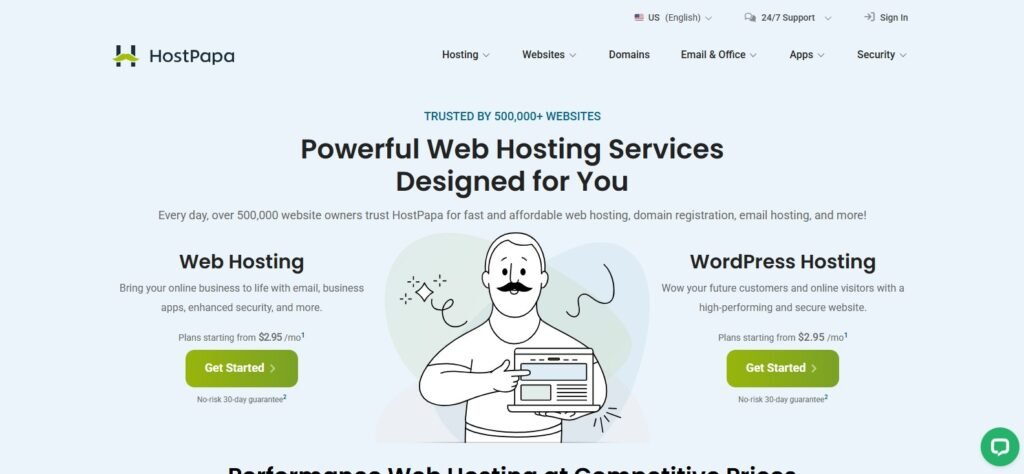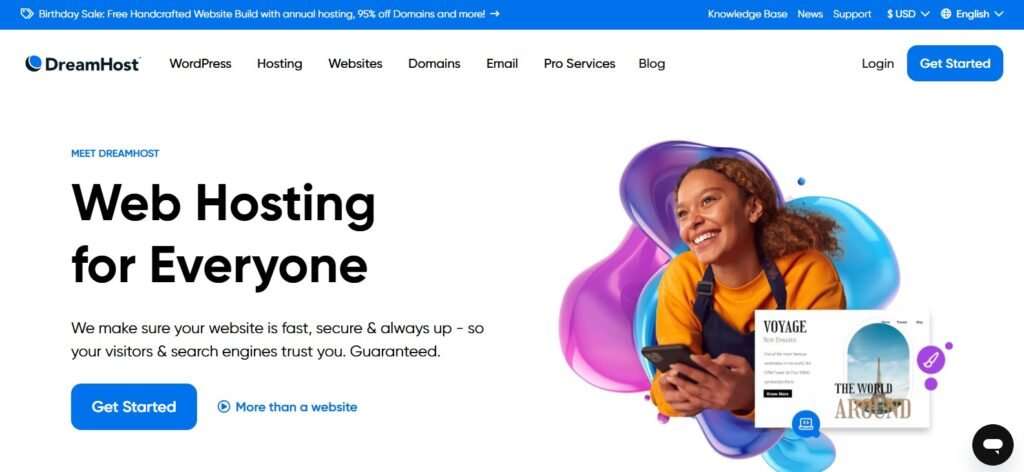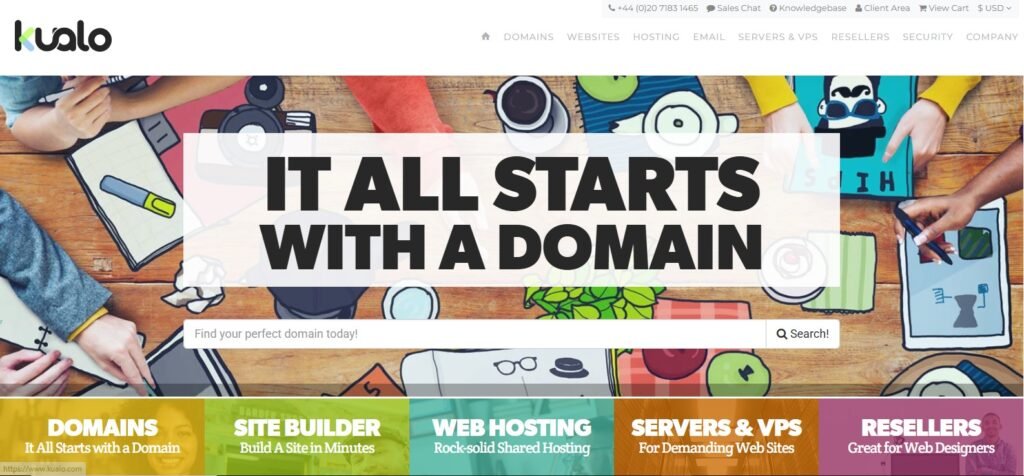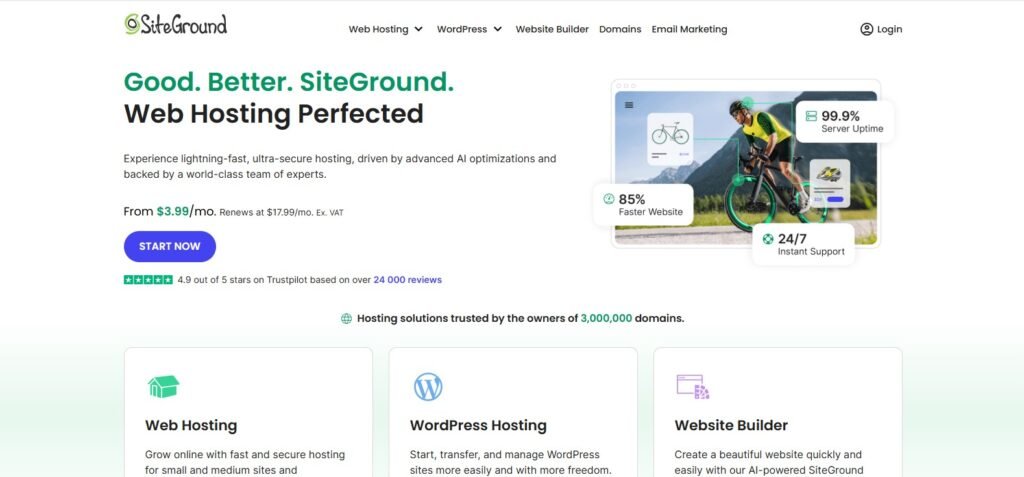Why Sustainability in Web Hosting Matters
1. The Internet Has a Hidden Carbon Footprint
Every search, click, and page load consumes electricity. Behind every website sit thousands of servers running 24 hours a day in data centres that require massive cooling systems. Collectively, the global internet is estimated to produce 2 – 3 % of total CO₂ emissions — roughly equal to the airline industry. That means every website, no matter how small, contributes to environmental impact.
Traditional hosting companies often rely on energy from fossil-fuel-powered grids. These servers draw power continuously, even when traffic is low, leading to unnecessary carbon emissions. For beginners and small business owners who want to build ethically responsible brands, the question is simple: Can your website exist without hurting the planet?
The answer — yes, through eco-friendly or green web hosting.
2. What Is “Green Hosting”?
Green hosting refers to web hosting companies that take intentional steps to minimise or offset their carbon footprint. They do this through one or more of the following:
Using renewable energy (solar, wind, hydro, geothermal) to power data centres.
Purchasing Renewable Energy Certificates (RECs) to offset electricity drawn from traditional grids.
Implementing energy-efficient hardware such as SSD/NVMe drives and low-power processors.
Optimising cooling systems and airflow management to reduce waste heat.
Planting trees or supporting carbon-offset projects to compensate for unavoidable emissions.
Some leaders in the industry—like GreenGeeks and HostPapa—go beyond neutrality by putting back more renewable energy than they consume (e.g., GreenGeeks replaces 300 % of its usage with renewable credits).
In essence, green hosting isn’t just about saving the planet; it’s about building a faster, cleaner, and more responsible web.
3. Why Beginners Should Care
At first glance, sustainable hosting might sound like something for large corporations or NGOs. In reality, beginners benefit the most. Here’s why:
Reputation & Trust: Today’s visitors value authenticity. Hosting sustainably communicates that your brand genuinely cares about social impact.
SEO Advantage: Google prioritises fast, secure, and responsible websites. Green hosts often run on newer, more efficient hardware—translating into faster load times.
Future Proofing: Environmental regulations are tightening globally. Choosing a renewable-powered host now ensures compliance and brand resilience.
Education: Starting sustainably teaches you best practices early—building habits that will scale with your future projects.
4. Myth: Green Hosting = Expensive or Slow
That used to be true a decade ago. Today, competition and technology have levelled the field. Modern eco-hosts use the same or better infrastructure as mainstream providers, often with SSD/NVMe drives, CDN integration, and load balancing. Many entry-level plans cost under $3 per month, and include free domain + SSL bundles. You’re not paying a “green tax”—you’re getting performance and principles.
What Makes a Web Host Truly Eco-Friendly?
The term “green hosting” is everywhere today — but not every company that uses it is genuinely sustainable. Some hosts purchase minimal carbon credits and label themselves eco-friendly for marketing purposes. Others have fully transformed their infrastructure to operate on renewable energy, reduce waste heat, and support global sustainability programs.
If you care about authentic green hosting, here’s how to separate real sustainability from greenwashing.
1. Renewable Energy Sources — The Foundation of Green Hosting
The biggest contributor to a web host’s environmental impact is its power consumption.
Data centres run 24/7, and the electricity used to keep servers online and cool accounts for almost 70% of their carbon footprint.
True green hosts rely on renewable energy in one of two ways:
Direct renewable sourcing: Powering data centres entirely with solar, wind, or hydroelectric energy.
Renewable Energy Certificates (RECs): Purchasing certified credits to offset the carbon from grid electricity.
For example, GreenGeeks replaces 300% of the energy it consumes by investing in renewable energy projects, while HostPapa powers its Canadian data centres with 100% renewable hydroelectric energy.
Tip: When comparing providers, always ask — “Do you directly use renewable power, or do you offset through credits?” Direct use is better, but high-quality RECs are still valuable.
2. Energy Efficiency and Hardware Optimization
Even if a host uses renewable power, inefficiency still wastes resources.
That’s why top eco-hosts focus on hardware efficiency, not just clean energy.
Key indicators include:
Modern SSD or NVMe drives (use less energy and load data faster).
Low-power CPUs and virtualized servers to maximize computing efficiency.
Advanced cooling systems that reuse or redirect waste heat.
High PUE ratings (Power Usage Effectiveness) — look for PUE < 1.3.
For example, Kualo and Greenhost design data centres that recycle heat for nearby facilities. That’s innovation beyond offsets — it’s sustainability in action.
3. Verified Environmental Certifications
A truly sustainable provider doesn’t just make claims — it provides proof.
Look for at least one of these certifications or memberships:
| Certification | What It Means |
|---|---|
| Green-e | Confirms renewable energy sourcing and REC legitimacy. |
| EPA Green Power Partner | U.S.-based recognition for renewable usage. |
| The Green Web Foundation Listing | Public directory of verified green hosts globally. |
| Climate Neutral or B Corp Certification | Indicates overall business sustainability standards. |
If a host isn’t transparent about certifications, request documentation or visit The Green Web Foundation directory.
4. Carbon Offsets and Reforestation Initiatives
Some hosts go beyond energy management by funding tree-planting, carbon capture, or sustainability grants.
For instance:
GreenGeeks plants one tree for every hosting account purchased.
DreamHost offsets its carbon footprint via verified renewable energy credits and environmental partnerships.
These initiatives add tangible value — they help rebalance the unavoidable emissions from hardware manufacturing and transportation.
5. Transparency and Accountability
The strongest green hosting companies publish annual sustainability reports showing:
Total energy consumption
Source of renewable power
Emission offsets achieved
Efficiency improvements year-over-year
Transparency proves commitment and allows users to verify that their websites are truly hosted sustainably.
Top Green Web Hosting Providers for 2025
Finding a web host that is both eco-friendly and high-performing can feel like a balancing act. Many claim to be “green,” but few combine environmental responsibility with speed, uptime, and customer support.
Below are the top five truly sustainable hosting providers leading the green web revolution — all verified for renewable energy use, transparency, and reliable service.
🌎 1. GreenGeeks – The Industry Leader in Eco Hosting

Website: www.greengeeks.com
Quick facts:
Energy Source: 300% renewable energy offset (they replace 3x the power they consume).
Certifications: EPA Green Power Partner, Green-e certified.
Pricing: From $2.95/month with free SSL, domain, CDN, and daily backups.
Support: 24/7 live chat & email.
Why it stands out:
GreenGeeks doesn’t just offset emissions — it overcompensates. For every unit of energy used, they invest three units in renewable energy projects. Their infrastructure is modern, running on NVMe SSD storage, LiteSpeed servers, and HTTP/3, which means your sustainable website also loads lightning fast.
They also plant a tree for every new hosting account, supporting global reforestation.
Best for: beginners, small businesses, and eco-focused brands that want proven sustainability + speed.
🍃 2. HostPapa – 100% Renewable Energy Hosting

Website: www.hostpapa.com
Quick facts:
Energy Source: 100% renewable (wind and hydro).
Pricing: From $3.95/month, includes free domain, SSL, and email.
Support: 24/7 live chat and phone.
Why it stands out:
HostPapa powers its entire network with certified renewable energy. Their eco-friendly approach extends to every part of their business, including offices and staff training.
Performance-wise, HostPapa is fast, stable, and beginner-friendly, offering cPanel access, automated WordPress setup, and strong uptime.
Best for: small businesses, local brands, and personal sites seeking ethical hosting with North American or European data centres.
🌬️ 3. DreamHost – Carbon-Neutral Transparency

Website: www.dreamhost.com
Quick facts:
Energy Source: 100% carbon neutral via renewable credits.
Pricing: From $2.95/month.
Guarantee: 97-day money-back (longest in industry).
Why it stands out:
DreamHost is one of the oldest independent web hosts (founded 1997) and has maintained a strong environmental ethos for decades. Their offices and servers operate on energy-efficient infrastructure, and they offset all carbon emissions through verified RECs.
They also advocate for open-source innovation — reducing wasteful proprietary bloat.
Best for: bloggers and small companies that value transparency and independence.
🌱 4. Kualo – Verified 100% Renewable Power (UK-Based)

Website: www.kualo.com
Quick facts:
Energy Source: 100% renewable via Green-e certification.
Pricing: From £2.99/month.
Unique feature: Recycles waste heat to warm nearby buildings.
Why it stands out:
Kualo goes beyond offsets — it’s a Green Web Foundation verified host and uses eco-efficient data centres that actively recycle energy. Their servers use SSD storage, and they offer free migration, automatic backups, and an easy site builder.
They also power their offices sustainably and participate in tree-planting programs.
Best for: European or UK customers who want verified sustainability with strong uptime.
🔋 5. SiteGround – Google Cloud + Renewable Energy Match

Website: www.siteground.com
Quick facts:
Energy Source: Google Cloud infrastructure (100% renewable matched).
Pricing: From $14.99/month (GrowBig).
Support: World-class 24/7 support, free CDN, and caching tools.
Why it stands out:
SiteGround hosts on Google Cloud’s renewable network, which matches every watt of power with clean energy credits. It combines sustainability with enterprise-level performance — powerful caching, real-time server monitoring, and top-tier security.
While pricier, its superior uptime, speed, and expert support make it a top choice for brands that can afford quality and responsibility.
Best for: growing businesses and eco-conscious professionals who want premium hosting.
Quick Comparison Table
| Provider | Renewable Energy | Price (Starting) | Certification | Best For |
|---|---|---|---|---|
| GreenGeeks | 300% offset | $2.95/mo | EPA, Green-e | Overall best |
| HostPapa | 100% renewable | $3.95/mo | Green-e | Small business |
| DreamHost | Carbon-neutral | $2.95/mo | REC verified | Transparency |
| Kualo | 100% renewable | £2.99/mo | Green Web Foundation | UK/EU sites |
| SiteGround | 100% renewable match | $14.99/mo | Google Cloud verified | Premium users |
How to Migrate or Launch Your Website on a Green Host
You’ve chosen to make your website part of the solution — not the problem.
But how do you actually move your existing site (or launch a new one) without losing data, visitors, or performance?
Migrating to an eco-friendly hosting provider is easier than you might think — especially now that many green hosts offer free migrations, automatic backups, and 24/7 live support.
Let’s break it down step-by-step.
1. Evaluate Your Current Hosting Situation
Before moving, take stock of your existing setup. Ask:
Where is my site currently hosted?
How much storage and bandwidth am I using?
Is my CMS (WordPress, Shopify, etc.) compatible with my target host?
Next, use the Green Web Foundation checker to see if your current host is listed as eco-friendly.
👉 https://www.thegreenwebfoundation.org/tools/check
If it’s not listed, that means your current data centre is still powered by fossil fuels — a good reason to migrate.
2. Choose the Right Green Host
Pick a provider that aligns with your goals:
For affordability and performance: GreenGeeks or HostPapa.
For transparency and simplicity: DreamHost.
For UK/EU sustainability standards: Kualo or Greenhost.
For enterprise performance: SiteGround (Google Cloud-powered).
Look for these features:
✅ Verified renewable energy sourcing
✅ Free SSL and domain
✅ Automatic backups and easy control panel
✅ 24/7 chat support (for migration help)
Remember: eco-friendly hosting doesn’t have to be expensive — most of these plans start around $2.95 to $4.99/month.
3. Back Up Your Site
Always make a full backup before migration.
For WordPress, you can use plugins like UpdraftPlus or All-in-One WP Migration.
Backup checklist:
Database (.sql)
Website files (themes, plugins, media)
Email accounts (if applicable)
If you’re unsure how to do this, ask your new host’s live chat — most will handle backups for you.
4. Migrate Your Website (3 Easy Options)
1️⃣ Host-Assisted Migration: Most top hosts (GreenGeeks, DreamHost, SiteGround) offer free site transfers handled by technicians.
2️⃣ Plugin-Based Migration: For WordPress, use a migration plugin to copy your site to the new host.
3️⃣ Manual Migration: Upload files via FTP, import database, and point DNS manually (recommended only for experienced users).
Always test your site in a staging environment before switching DNS to avoid downtime.
5. Point Your Domain and Activate SSL
After migration:
Update your domain’s DNS records to the new host’s nameservers.
Enable the free SSL certificate (usually one click in the dashboard).
Verify HTTPS works by visiting your site.
If you see mixed content warnings, run a plugin like “Really Simple SSL” to auto-fix them.
6. Optimize for Sustainability
Green hosting is the first step. The second is making your website energy-efficient:
Use image compression tools (TinyPNG, ShortPixel).
Enable caching to reduce server load.
Use a global CDN (e.g., Cloudflare) to serve content closer to users.
Clean up plugins and scripts to lower energy consumption.
Host videos externally (like YouTube) instead of using server bandwidth.
These practices make your site faster, cheaper, and greener.
7. Communicate Your Green Commitment
Let visitors know your site supports sustainability.
Add a badge like:
“This website is powered by 100% renewable energy.”
It boosts brand credibility and inspires others to follow your lead.
Many hosts (like GreenGeeks and Kualo) even offer free “Eco Badge” images for customers to display.
Building a Long-Term Strategy for Sustainable Web Hosting
Choosing an eco-friendly host is the first step toward running a responsible online presence — but sustainability doesn’t stop there. True digital sustainability is an ongoing commitment to minimizing waste, optimizing efficiency, and inspiring others to follow your example.
Here’s how to maintain and evolve your green website strategy for the long haul.
1. Keep Auditing Your Hosting Provider’s Credentials
Sustainability isn’t static. Hosting companies can change ownership, data centre providers, or renewable contracts.
At least once a year, recheck your host’s listing in The Green Web Foundation Directory or verify their certifications (like Green-e, EPA Green Power Partner, or ISO 50001).
If your host ever stops publishing annual sustainability reports or becomes vague about its energy sources — treat that as a red flag and start exploring alternatives. Transparency is the backbone of long-term green trust.
2. Monitor Your Website’s Carbon Footprint
Even with green hosting, your website consumes electricity based on its traffic volume, file size, and design complexity.
You can use tools like:
Website Carbon Calculator (websitecarbon.com)
Ecograder (ecograder.com)
These tools estimate how much CO₂ your pages generate per visit.
To lower that number:
Optimize images (use next-gen formats like WebP/AVIF).
Limit heavy JavaScript or animations.
Enable caching and lazy loading.
Delete unnecessary plugins and database clutter.
Remember: a faster website is a greener website.
3. Choose Sustainable Design and Development Practices
Every design choice affects energy consumption.
Use lightweight themes, minimalist fonts, and dark backgrounds when suitable (reduces display energy on OLED screens).
If you run an eCommerce site, compress product images and batch-load galleries.
Developers can also practice “green coding” — writing efficient scripts that reduce CPU load and data transfer.
It’s not just technical excellence — it’s environmental responsibility.
4. Support Broader Environmental Initiatives
Your commitment doesn’t have to stop at hosting.
You can:
Donate a portion of sales to tree-planting initiatives (like One Tree Planted).
Join Tech Zero or Climate Neutral organizations.
Encourage your team to adopt sustainable digital habits — from using cloud collaboration tools to reducing unnecessary emails.
This builds a values-driven culture around your website or business, enhancing both reputation and impact.
5. Communicate Your Green Mission
People connect with brands that share their values.
Showcase your sustainability efforts proudly:
Add a “Powered by Green Hosting” badge.
Create an “Environmental Policy” or “Sustainability” page on your website.
Share milestones (“Our site has saved 250 kg of CO₂ emissions this year”).
This not only educates visitors but also strengthens loyalty and trust.
Sustainability becomes part of your brand story — not just a technical choice.
6. Plan for Growth Responsibly
As your website traffic grows, you may need to scale from shared hosting to VPS or cloud hosting.
When that time comes, stay within the green ecosystem — choose cloud services powered by renewable data centres (like Google Cloud, AWS Green Regions, or Microsoft Azure’s carbon-neutral network).
Ask your provider:
“Can you guarantee my upgrade will stay 100 % renewable-powered?”
A proactive question today prevents future compromises tomorrow.
7. The Ripple Effect of a Green Website
Your single website might seem small — but every page view powered by renewable energy makes a measurable difference.
If thousands of creators, developers, and businesses made the same decision, we could reduce millions of tons of CO₂ emissions annually.
That’s the real beauty of sustainable hosting: small individual actions combining into global impact.
Final Thoughts
Eco-friendly web hosting isn’t a marketing trend — it’s a digital evolution.
By choosing a renewable-powered host, maintaining an efficient website, and communicating your sustainability journey, you’re doing more than running a site.
You’re helping build a cleaner, faster, and more ethical internet.
Your website now stands as proof that technology and environmental stewardship can thrive together — a truly sustainable digital footprint. 🌱



